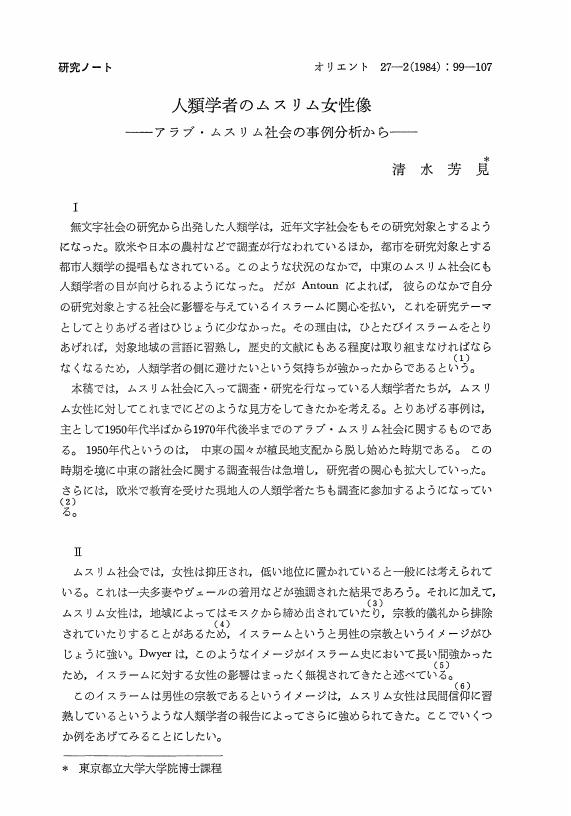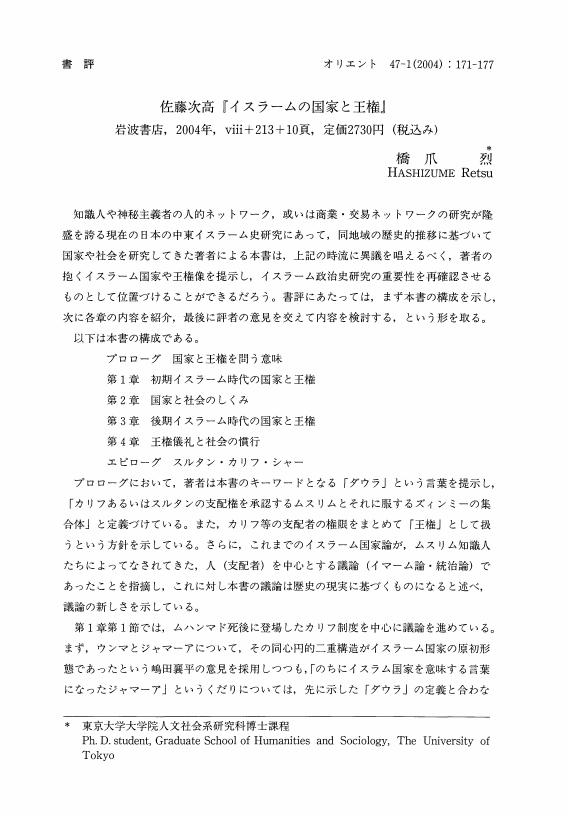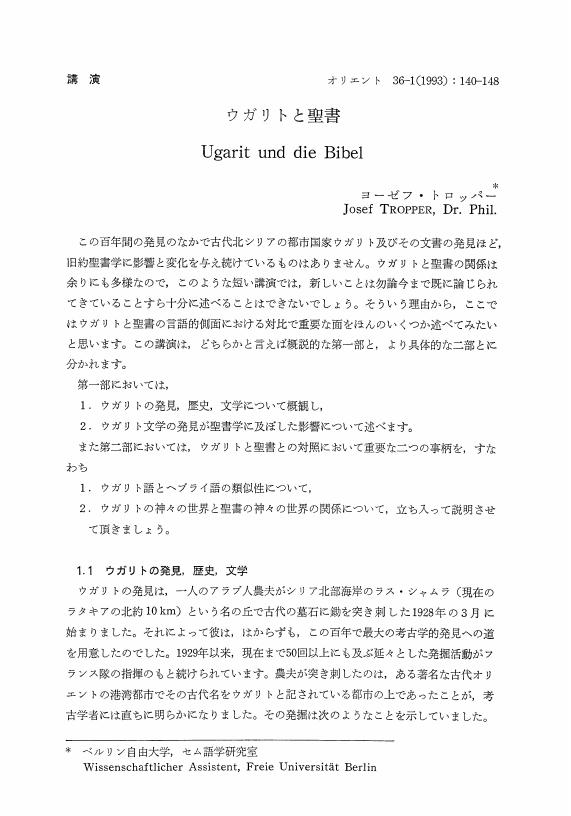- 著者
- 秋葉 淳
- 出版者
- 一般社団法人 日本オリエント学会
- 雑誌
- オリエント (ISSN:00305219)
- 巻号頁・発行日
- vol.56, no.1, pp.84-97, 2013-09-30 (Released:2016-10-01)
- 参考文献数
- 54
It has been generally accepted that in Ottoman society Muslim girls were not excluded from elementary education in the traditional schools (mekteb). However, there is no study that addresses the issue of to what extent girls' education was widespread before the Tanzimat reforms. Although some studies have mentioned the existence of female teachers for girls, they only gave a general description without references or drew on a limited number of examples, and no further investigation has been conducted. This article presents some findings on girls' schools and female teachers in Ottoman society based on two documents, dating from the 1780s and 1811, which provide lists of mektebs located in Istanbul. These documents show that there were a fairly large number of girls' schools: about one-sixth of the schools listed in the first document and about one-third of those in the second document were for girls. Noticeably, most of them were taught by female teachers. Many of the girls' schools with female teachers were probably schools of modest size without an independent school building where the students gathered in the teachers' houses for instruction. However, since mixed schools for boys and girls are known to have been common, one can safely assume that the opportunity for elementary education for girls was significantly richer than is generally supposed for a "traditional" Muslim society. The existence of a large number of female teachers suggests that some women could acquire an education sufficient for teaching children. Their appearance in the official documents also shows that their occupation was socially recognized.
7 0 0 0 OA 古代イランの犬
- 著者
- 井本 英一
- 出版者
- 一般社団法人 日本オリエント学会
- 雑誌
- オリエント (ISSN:00305219)
- 巻号頁・発行日
- vol.12, no.3-4, pp.1-22,220, 1969 (Released:2010-03-12)
The four-eyed dog is found in the Yama cycle of the Rig Veda, where two four-eyed dogs lead the dead to the fathers in heaven. In the Avestan Videvdat, however, a white dog, spotted with yellow on the ears, plays an important role in the funeral rites, and among the modern Parsees it appears at the Sag-did ceremonies again.Ethnography supports the dog and spottedness symbolism in the wide territorial extent and requires some correction of views which, for example, the late Rev. M. Modi has expounded.Originally the two dogs represented the death and the rebirth, which later have been incorporated in one dog with spotted colour and four eyes.The writer also interprets, against Prof. P. Thieme, Rig Vedic çvagbnin- as one who playing dice at the rite of passage gains two aces, a deuce-ace, and sacrifices the four-eyed dog in order to become sacred, renovate oneself and get rebirth.
7 0 0 0 OA 第47回大会
- 出版者
- 一般社団法人 日本オリエント学会
- 雑誌
- オリエント (ISSN:00305219)
- 巻号頁・発行日
- vol.48, no.2, pp.206-248, 2005 (Released:2010-03-12)
7 0 0 0 OA アッカド語文献資料に関連した最近の研究会活動について
- 著者
- 川崎 康司
- 出版者
- 一般社団法人 日本オリエント学会
- 雑誌
- オリエント (ISSN:00305219)
- 巻号頁・発行日
- vol.43, no.2, pp.149-153, 2000 (Released:2010-03-12)
7 0 0 0 OA アラン・ミカイル著『オスマン朝期エジプトにおける自然と帝国――環境の歴史』
- 著者
- 熊倉 和歌子
- 出版者
- 一般社団法人 日本オリエント学会
- 雑誌
- オリエント (ISSN:00305219)
- 巻号頁・発行日
- vol.55, no.1, pp.62-66, 2012-09-30 (Released:2016-04-26)
7 0 0 0 OA 7-10世紀ビザンツ=アラブ間の商業交渉について
- 著者
- 相野 洋三
- 出版者
- 一般社団法人 日本オリエント学会
- 雑誌
- オリエント (ISSN:00305219)
- 巻号頁・発行日
- vol.20, no.1, pp.153-164, 1977-09-30 (Released:2010-03-12)
6 0 0 0 OA シュメールの学校教育
- 著者
- ファーディ アブドゥール・アル 杉 勇
- 出版者
- 一般社団法人 日本オリエント学会
- 雑誌
- オリエント (ISSN:00305219)
- 巻号頁・発行日
- vol.18, no.2, pp.101-107, 1975 (Released:2010-03-12)
6 0 0 0 OA 革命状況と説教者 -イラン立憲革命の場合-
- 著者
- 加賀谷 寛
- 出版者
- 一般社団法人 日本オリエント学会
- 雑誌
- オリエント (ISSN:00305219)
- 巻号頁・発行日
- vol.33, no.2, pp.53-64, 1990 (Released:2010-03-12)
6 0 0 0 OA イスラム医学の脳と精神 11世紀の機械論的解釈
- 著者
- 矢口 直英
- 出版者
- 一般社団法人 日本オリエント学会
- 雑誌
- オリエント (ISSN:00305219)
- 巻号頁・発行日
- vol.54, no.1, pp.120-138, 2011-09-30 (Released:2015-02-27)
This article examines the medieval Islamic understanding of the workings of the brain as represented in Hunayn ibn Ishaq’s (d. 873) Questions on Medicine and the eleventh-century commentary on that work by Ibn Abī Ṣādiq al-Naysābūrī. Medieval Islamic physicians classified the human faculties into three categories: natural, animal, and psychic. They further subdivided the psychic faculties into those of voluntary movement, sensation, and psychic activities proper (including imagination, cogitation, and memory), and ascribed these faculties to the workings of the brain. Like other Islamic physicians, Ibn Abī Ṣādiq knew that movement and sensation required nerves, and the brain with which the nerves are connected. He posited a fine substance called the “psychic pneuma” (rūḥ nafsānīya) as the medium for movement and sensation, and movement and sensation were explained in terms of the mechanical operation of this matter. Being a material process, movement, according to him, requires tough nerves to transmit its power to the organs which are to be moved, whereas sensation, which is thought of as the imprinting of the images of the sensed objects, requires nerves that are tender. Psychic activities were also interpreted as an operation of psychic pneuma in the brain. For these activities were reckoned among the psychic faculties together with movement and sensation. Since the processes of these activities differ, these faculties have different seats in the brain which are of different qualities. For its part, the quality of the matter “pneuma” was believed to affect the quality of these faculties. Thus, Ibn Abī Ṣādiq formed a mechanistic theory of psychic faculties, which was in line with the tripartite theory of brain in Greek medicine. But, unlike the Greeks, he emphasised the materiality of brain and pneumata, and so it seems that he intended to establish the link of brain and mind.
6 0 0 0 OA 人類学者のムスリム女性像 -アラブ・ムスリム社会の事例分析から-
- 著者
- 清水 芳見
- 出版者
- 一般社団法人 日本オリエント学会
- 雑誌
- オリエント (ISSN:00305219)
- 巻号頁・発行日
- vol.27, no.2, pp.99-107, 1984 (Released:2010-03-12)
- 参考文献数
- 16
6 0 0 0 OA エジプトにおけるアラブ受給者登録簿としてのディーワーン
- 著者
- 森本 公誠
- 出版者
- 一般社団法人 日本オリエント学会
- 雑誌
- オリエント (ISSN:00305219)
- 巻号頁・発行日
- vol.19, no.2, pp.85-110,204, 1976 (Released:2010-03-12)
One of the most important institutions characterizing the early Caliphate was the system of diwan set up by 'Umar I. It had two aspects, i. e., one as a system of collecting taxes from the conquered peoples, and the other as that of distributing them, as pensions, to the Arabs. The latter is noteworthy because this system had influence not only on the Arab community but on the political, military and judical institutions in the Arab empire. In spite of this importance of the system, only the diwan of Medina established by 'Umar I has by now been examined and introduced to the scholarly world, no studies of those of the garrison towns (amsar) being available, except the case of Basra. Thus, the purpose of this paper is to shed light on the contents of diwiins which functioned as Arab rosters in Egypt, clarifying that they form the basic material of studies of the system of registration and pensions in the early Islamic Period. The first diwan of Egypt, including the names of 12, 300 to 15, 000 fighting men, was drawn up in A. H. 21, immediately after the Conquest. It is perceptible that three principles were adopted on the occasion of the registration: (1) to preserve the existing tribal groups as much as possible, (2) to reorganize tribes so that each group consists of a definite number of persons, and (3) to treat preferentially persons who contributed toward the expansion of Islam. As regards the second diwan drawn up by the governor 'Abd al-`Aziz b. Marwan, we have an important Greek papyrus from which we can infer the content of the diwan. This papyrus raises and answers many historical problems. For instance, the conclusion may be derived that unlike the common opinion of scholars, the use of Greek as official language before A. H. 87, when the Arab authority abolished it, was not restricted to the financial operations, but adopted for the registration of Arabs and the payment of pensions to them. Even if we admit that once the first diwan was drawn up in Arabic, it will not affect the above said conclusion.
- 著者
- 春田 晴郎
- 出版者
- 一般社団法人 日本オリエント学会
- 雑誌
- オリエント (ISSN:00305219)
- 巻号頁・発行日
- vol.51, no.1, pp.201-207, 2008-09-30 (Released:2014-03-30)
6 0 0 0 OA エジプト古王国時代の遺書にみる女性の立場
- 著者
- 吹田 真里子
- 出版者
- 一般社団法人 日本オリエント学会
- 雑誌
- オリエント (ISSN:00305219)
- 巻号頁・発行日
- vol.46, no.1, pp.103-117, 2003-09-30 (Released:2010-03-12)
The purpose of the present paper is to examine the position women held in the Old Kingdom of ancient Egypt. In the beginning of the last century, the heiress theory predominated in Egyptology. This theory held that, among royalty, the fixed and movable property was inherited through the female line. This applied also in private families. The position of women was therefore considered to be as high as that of men. In the 1960's, G. Robins published a paper denying the heiress theory. In the present paper, focus is placed on the disposition of the property in wills, imyt-pr in order to establish a conclusion about the actual status of women. I will examine the four wills, those of Metjen (Mtn), Khenemti (Hnmti), Ni-kau-ra (Ni-k_??_w-r_??_) and the sisters Pepi and Buwt (Ppi, Bwt).The wills address two types of property. One is property for the family; the other is the funeral foundation, which consists of arable lands given to the person who makes offerings for the deceased. The foundation could be given to only one person; it was not allowed to distribute among several people.The will disposes of the rights that the testator possessed, and shows his wish for his family to make offerings for him. The will thus has a legal function and also suggests religious desire.In ancient Egypt, anyone could make a will regardless of sex. Although women could make a will, fewer women did than men. I focus on the passages relating to women in the four wills. The emphasis is on the female priesthood of the funeral foundation. Women who became priests were able to possess the same status as men.
- 著者
- 橋爪 烈
- 出版者
- 一般社団法人 日本オリエント学会
- 雑誌
- オリエント (ISSN:00305219)
- 巻号頁・発行日
- vol.47, no.1, pp.171-177, 2004-09-30 (Released:2010-03-12)
- 著者
- ゴードン サイラス・H 津村 俊夫
- 出版者
- 一般社団法人 日本オリエント学会
- 雑誌
- オリエント (ISSN:00305219)
- 巻号頁・発行日
- vol.17, no.2, pp.1-12, 1974 (Released:2010-03-12)
- 参考文献数
- 7
5 0 0 0 OA ウガリトと聖書
- 著者
- トロッパー ヨーゼフ
- 出版者
- 一般社団法人 日本オリエント学会
- 雑誌
- オリエント (ISSN:00305219)
- 巻号頁・発行日
- vol.36, no.1, pp.140-148, 1993-09-30 (Released:2010-03-12)
5 0 0 0 OA 捨て子と再生
- 著者
- 井本 英一
- 出版者
- 一般社団法人 日本オリエント学会
- 雑誌
- オリエント (ISSN:00305219)
- 巻号頁・発行日
- vol.29, no.1, pp.1-16, 1986-09-30 (Released:2010-03-12)
Eiichi IMOTO, Abandonment of Infants and their Rebirth: Infants were abandoned in the mountains or on the water. They were never slain but reared up by men, animals or birds, and eventually returned to their native place.For example, Cyrus the Great, in his babyhood, was given to a cowherd at the foot of a mountain. Dara, a son of Humay, was, according to the Shahnama of Firdausi, abandoned by the water and found by a washerman. When he grew into a boy, Dara realized that he was of royal descent. He came home and was enthroned.Thus, infants were supposed to go to the world of totems and return to their native place endowed with a supernatural power.
5 0 0 0 OA 『反駁の書』の論理構造
- 著者
- 下山 伴子
- 出版者
- 一般社団法人 日本オリエント学会
- 雑誌
- オリエント (ISSN:00305219)
- 巻号頁・発行日
- vol.42, no.2, pp.129-145, 1999 (Released:2010-03-12)
Kitab al-naqd is a polemic work that Imami-Shi'i 'Abd al-Jalil Qazvini refutes the Sunni contender's accusations against Imami-Shi'i with almost word-for-word quotes from those accusations. It has been valued for the information about religious situations around Ray in the first half of the 12th century. Because of its polemical nature, however, its usability as a historical source has been questioned. The present paper intends to examine the logical framework of this text in order to get better position to evaluate it as a historical source. By “the logical framework” I mean each contender's standpoint and the structure of his way of thinking.Each contender brings forwards his arguments emphasizing advantageous aspects for him in the complicated situations of conflicts and alliances among several sects and schools (legal and theological) of both Sunni and Shi'i sides in Ray, as it follows.The arguments of the Sunni contender are based on the premise that the religious conflict in Ray exists only between “Sunni” and “Imami-Shi'i” . But 'Abd al-Jalil refers to another opposition between “Usuli” and “Jabli” sects to refute the above premise. “Usuli” is a subsect of Imami-Shi'i sect and “Jabri” is one of the Sunni. He insists that “Usuli” to which he belongs is prevalent and in good term with the Saljuq, while “Jabri”, which practically means Ash'ari theological school, is a minority and the Sunni author belongs to this sect. This insistence is based on the suppression of Ash'ari school by the Saljuq since 537/1142-3. 'Abd al-Jalil emphasizes that “Usuli” endorses the theological viewpoint of the Saljuq and opposes to that of Ash'ari school. Thus he stresses the legitimacy of “Usali” depending on the power of the Saljuq state.
5 0 0 0 OA 「タタール」 から 「アゼルバイジャン」 へ
- 著者
- 塩野崎 信也
- 出版者
- 一般社団法人 日本オリエント学会
- 雑誌
- オリエント (ISSN:00305219)
- 巻号頁・発行日
- vol.57, no.2, pp.41-62, 2015-03-31 (Released:2018-04-01)
- 参考文献数
- 80
It is common knowledge that Muslims living in the south-eastern part of Caucasus, now the Republic of Azerbaijan, were referred to as 'Tatars' without a clear distinction from other Turkic groups under the rule of the Russian Empire. These Muslims were also called 'Turkish people' (Turks) or Caucasian Muslims. In the latter part of the 19th century and during the early 20th century, a feeling of nationalism emerged among them and they began calling themselves 'Azerbaijanis'. However, no study clearly explains the reason they claim to be Azerbaijanis. The author scrutinised manuscripts, printed books, journals and newspapers written in several languages and discovered that 'Azerbaijan', the name of the nation, is not directly derived from the name of a geographical location, but from the name of a language. Around 1840, Kazem-bek, a professor at Kazan University, named the language spoken by Muslims in the South Caucasus as 'Azerbaijani Turkish'. Muslim intellectuals who lived in Tiflis, the centre of the South Caucasus in the 19th century, adopted the language name in the 1880s, following which they considered 'people who speak Azerbaijani Turkish' as a single nation called 'Azerbaijani'. The name of this nation initially appeared in the 115th issue of the literary journal Keshkul (Dervish Bowl), published in Tiflis on 16 November, 1890. Two major reasons for why Muslim intellectuals in Tiflis called themselves Azerbaijanis instead of Tatars, Turkish people and Caucasian Muslims are as follows : First, they wanted to avoid a name based on a religious belief, such as 'Muslim', because they thought that a nation must not be defined by its religion, but by its culture, customs and language. Second, they considered their culture, customs and language to be different from those of the Tatars in the Volga region and Crimean Peninsula, or Turkish people in the Ottoman Empire.
5 0 0 0 OA Avesta における風と馬
- 著者
- 岡田 明憲
- 出版者
- 一般社団法人 日本オリエント学会
- 雑誌
- オリエント (ISSN:00305219)
- 巻号頁・発行日
- vol.37, no.2, pp.157-169, 1994 (Released:2010-03-12)
The myths of the people of ancient Iran contain references of many animals and among them the horse is of particular importance. In mythological terms, the horse appears as the symbole of the warrior class. In the beliefs of the people of ancient Iran, the connection between the horse and the warrior was related to the ambiguity of the horse. In the Avesta, this is shown by the use of -aspa (horse) in proper names and in the opposition of the white horse and the black horse.Studies in ethnology show that the horse is frequently connected with deities of the wind. It is not unusual, for example, for a horse to serve as a sacrifice to the deity of the wind. In the Avesta, too, passages hinting at the ties between horses and the wind can be found. In Zoroastrianism, wind possesses opposing qualities. Vayu, the god of wind, presents a clear duality. The twin Mainyus of good and evil reside in Vayu, like Zurvan.Wind is the demarcation between life and death, situated between this world and the after life, as demonstrated in the Haδoxt Nask and the Aogemadaeca. The horse, too, represents the character of being this boundary or being situated in the between. This point can be seen in the horse as a metamorphosis of Verethraghna as well as the Gushnasp fire venerated during the Sassanian dyansty. The proof for the tie with the boundary is the prayer on horseback frequently mentioned in the Avesta.










